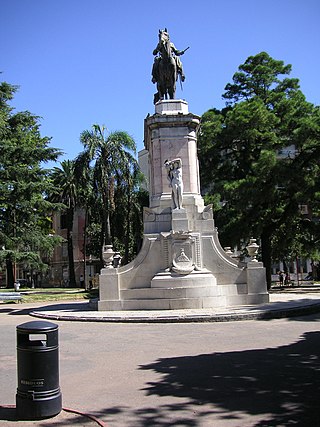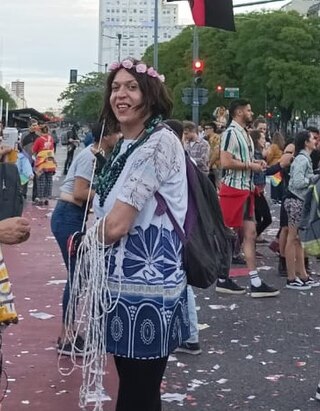
Nilcedes Soares de Magalhães, known professionally as Glória Menezes, is a Brazilian actress.

Lesbian, gay, bisexual, and transgender (LGBT) rights in Uruguay rank among the highest in the world. Same-sex sexual activity has been legal with an equal age of consent since 1934. Anti-discrimination laws protecting LGBT people have been in place since 2004. Civil unions for same-sex couples have been allowed since 2008 and same-sex marriages since 2013, in accordance with the nation's same-sex marriage law passed in early 2013. Additionally, same-sex couples have been allowed to jointly adopt since 2009 and gays, lesbians and bisexuals are allowed to serve openly in the military.

Laura Ana "Tita" Merello was an Argentine film actress, tango dancer and singer of the Golden Age of Argentine Cinema (1940–1960). In her six decades in Argentine entertainment, at the time of her death, she had filmed over thirty movies, premiered twenty plays, had nine television appearances, completed three radio series and had had countless appearances in print media. She was one of the singers who emerged in the 1920s along with Azucena Maizani, Libertad Lamarque, Ada Falcón, and Rosita Quiroga, who created the female voices of tango. She was primarily remembered for the songs "Se dice de mí" and "La milonga y yo".

China Zorrilla was an Uruguayan theater, film, and television actress, also director, producer and writer. An immensely popular star in the Rioplatense area, she is often regarded as a "Grand Dame" of the South American theater stage.

Plaza Independencia is the most important city square in Montevideo, Uruguay, laid out in the 19th century in the area occupied by the Citadel of Montevideo. In its center is a monument to General José Gervasio Artigas, and below it, his mausoleum.

Barrio Sur is a barrio of Montevideo, Uruguay. It borders Ciudad Vieja to the west, the central business district to the north, Palermo to the east and the coastline to the south.

Plaza Zabala is a plaza in the Ciudad Vieja of Montevideo, Uruguay. In late 1878, during the dictatorship of Colonel Lorenzo Latorre, it was decided to demolish the old fort and build a public square in its place. But for 12 years this site remained a wasteland. The Plaza finally came to be established only on December 31, 1890 when the equestrian statue of Bruno Mauricio de Zabala was installed. It was sculpted by the Spanish sculptor Lorenzo Coullaut Valera in collaboration with the Basque architect Pedro Muguruza Otaño and inaugurated on December 27, 1931.

Leonardo Garet is a Uruguayan writer, teacher, and member of the National Academy of Uruguay.

Libertador Avenue is a major avenue in Montevideo, Uruguay. It stretches north from the Legislative Palace in Aguada to Plaza Fabini in Centro, and is named after Juan Antonio Lavalleja, revolutionary figure and politician, who led the group of the Thirty-Three Orientals in the insurrection for the independence of Oriental Province.

LGBT in Argentina refers to the diversity of practices, militancies and cultural assessments on sexual diversity that were historically deployed in the territory that is currently the Argentine Republic. It is particularly difficult to find information on the incidence of homosexuality in societies from Hispanic America as a result of the anti-homosexual taboo derived from Christian morality, so most of the historical sources of its existence are found in acts of repression and punishment. One of the main conflicts encountered by LGBT history researchers is the use of modern concepts that were non-existent to people from the past, such as "homosexual", "transgender" and "travesti", falling into an anachronism. Non-heterosexuality was historically characterized as a public enemy: when power was exercised by the Catholic Church, it was regarded as a sin; during the late 19th and early 20th centuries, when it was in the hands of positivist thought, it was viewed as a disease; and later, with the advent of civil society, it became a crime.

Marlene Wayar is an Argentine social psychologist, travesti-transgender activist, and author of the book Travesti: una teoría lo suficientemente buena.
Liberal homophobia is the acceptance of homosexuality as long as it remains hidden. It is a type of homophobia in which, despite acceptance of sexual diversity, prejudices and stereotypes that marginalize or underestimate LGBT people are perpetuated.

Karina Pankievich is a Uruguayan trans rights activist. She is the president of Trans Association of Uruguay.

The Ministry of Women, Genders and Diversity was a ministry of the Argentine Government tasked with overseeing the country's public policies on issues affecting women and gender and sexual minorities. The ministry was created in 2019, as one of the initial measures of President Alberto Fernández; the first minister was Elizabeth Gómez Alcorta.
Carlos Jáuregui was an Argentine LGBT rights activist. He founded La Comunidad Homosexual Argentina in 1984. In the early 1990s, he set up Gays por los Derechos Civiles and organised the first Pride march in Buenos Aires. He died from an HIV-AIDS-related illness at the age of 38. In memorial, a national day of activism for sexual diversity was established. He was posthumously given the Felipa de Souza Award, and, in 2017, a station was renamed after him on the Buenos Aires Underground.
The Centro de Fotografía de Montevideo, Uruguay, (CdF) is a photography center dedicated to the conservation, documentation, generation, investigation, and dissemination of photographic images of interest to Uruguayans and Latin Americans. It is part of the Information and Communication Division of the City of Montevideo.

Gloria Álvez Mariño was a Uruguayan trans rights activist. She was a founder of the Transvestite Organizing Table (MCT), which later became Trans Association of Uruguay (ATRU). Mariño was also the president and secretary of ATRU.

Gloria Meneses was a Uruguayan performer and activist who lived openly as travesti from 1950 until her death. Highly unusual in Latin America at the time, Meneses' life has been widely honoured in films and exhibitions.















